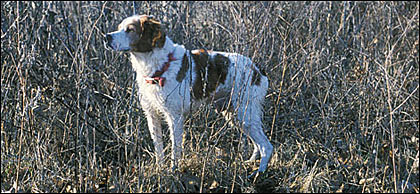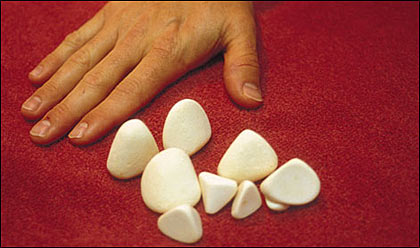Prevention is key to a healthier dog and a good way to save money.
By Joel Vance
 Pucques on point. |
There's an old song titled "Rex, the Piddling Pup," about a dog that watered every tree, every bush. Though the lyrics don't mention it, it's possible Rex was suffering from a bladder stone. Or he might just have been territorially enhanced. Male dogs spend much time practicing their three-legged stance, but we noticed that Pucques, one of our French Brittanies, spent more time with his hind leg lifted than he did on a classic point with his foreleg lifted. And then we began to see blood in his urine.
At no time did he show signs of pain or strain. He hunted hard and seemed in perfect health. But you don't ignore bloody urine, hoping it will go away. An X-ray revealed he had a bladder stone the size of a grape. He wasn't going to pass one like that--ask anyone who ever has passed one the size of a pinhead. That size is enough to bring strong men to their knees, howling like the coyotes on the lone prairie.
Bladder stones are not the same as kidney or gallstones, though the first two are connected with the urinary tract (gall bladder stones are part of the hepatobiliary system). There are two common symptoms to bladder stones--frequent urination or passing blood, both of which Pucques showed. Bladder stones are called uroliths, for those who like to stun people at parties with arcane trivia. They form like pearls in oysters, an accretion of crystals around a core--but you won't see Elizabeth Taylor, the princess of Blackglama pearls, wearing a priceless necklace of bladder stones. The blood occurs because the abrasive stone rubs against the wall of the bladder. If the dog passes tiny stones the problem is solved, at least temporarily, but the danger is that a stone will lodge in the urethra and block urine passage. Then the bladder could burst, which is fatal.
Bladder stones are far more common than kidney stones. "I don't think I've seen a half dozen kidney stones in my time as a vet," says Dr. Roger Dozier, a veterinarian who has been in practice for more than three decades. "But we get several bladder stones every year."
Pucques's stone turned out to be a "struvite." This is the most common form of bladder stone (a survey found that more than 50 percent of stones studied were struvites). Technically struvites are a "magnesium, ammonium, phosphate hexahydrate" if you want to impress (or bore the brush pants off) people at parties. There were two options with Pucques: (1) Try to dissolve the stone with an acidic diet or (2) operate.
"It's generally safer to dissolve the stones with females," said Roger's partner, Dr. Jerry Demuth, who did the operation. "But with males, when the stone gets small enough to pass there's a chance it will lodge in the urethra and then it's major surgery."
Pucques's "stone" was an accretion of a number of smaller stones. Dr. Demuth said that one of the smaller pieces was just about right to have lodged if it hadn't become part of the larger stone. It's less painful for the dog to have the stone surgically removed but certainly less expensive if the dog passes the stone itself (the dog might not look at it that way, though). Any surgery carries some risk, but the surgery is comparatively simple and recovery time from a bladder operation is remarkably quick.
 Doctor Jerry Demuth with Pucques in the vet examining room. |
We opted for the surgery and Pucques was home within 24 hours with a shaved crotch, but otherwise showing no sign of discomfort. His first act out of the vehicle was to lean against a deck post and water it profusely. It's hard to tell with a dog, but I think his expression was one of profound relief. The stone went to a lab in St. Paul for analysis by Dr. Carl Osborne at the University of Minnesota Veterinary College Urolith Center, who has specialized in analyzing bladder and other urinary stones. Lab analysis is vital to identify the type of stone, which, in turn, indicates the treatment required.
There are at least 20 types of bladder stones. Pucques's stone was formed in a highly alkaline urinary tract. Dr. Demuth showed me another type that was the size of a half-dollar and as solid as road gravel. "This is the dangerous kind," he said. "They keep coming back."
PREVENTATIVE MEASURES
Stone prevention beats an operation six ways from Sunday. It's far less expensive to stop stones before they start because repeated operations do damage to the bladder, not to mention the pocketbook. Preventive medicine can be as simple as a prescribed diet, depending on the type of stone. In addition, the dog should have fresh water and exercise enough to urinate frequently. Housedogs that don't get out often to urinate certainly would be prone to more problems than an active hunting dog, but off-season inactivity could contribute to stones in a dog predisposed to getting them. All vets stress the need for water and urination as preventives.
Some breeds are more prone to bladder stones than others. Dalmatians are prominent, but some of the smaller breeds, like schnauzers, also are targets. Bird dogs are not among the stone-prone breeds, but obviously they aren't immune from them, either.
While kidney stones, if they're small enough, can be blasted by shock waves (called extracorporeal lithotripsy if you need another party trivia stunner), the shock waves can't target bladder stones, which can move around in the bladder. The shock wave merely shoves the stone aside, rather than pulverizing it.
In extreme cases of bladder stones where there has been previous surgery or where the dog is not considered a good risk for surgery, some vet hospitals will do shock treatment. It's not cheap: figure $1,000-$1,500 with follow-up treatment that can add several hundred more dollars. Removal of the stone from the bladder is about a $500-bite, not counting follow-up visits and medication. While the surgery is gross, it's relatively simple--the vet makes an incision in the dog's pelvic area, fishes the bladder out like a balloon, makes another incision in the bladder, removes the stone, flushes out the bladder, sews it up, then sews up the exterior incision. When the dog wakes up it may be a little cool around the shaved area, but otherwise is as good as new. A round of antibiotics completes the surgical part of the problem. Stick a pill in a bit of cheese or meat and dogs eagerly gulp it down.
The bladder stones that form in alkaline urine can result from a grain-based diet, though dog food manufacturers increasingly are going to formulas that include more meat and less grain. Food that is meat-base
d is more acidic. Humans who suffer bladder infections or stones can help prevent trouble by drinking cranberry juice, which is acidic--but it's doubtful you can get your dog to drink cranberry juice. Some stones form in acidic urine, some in alkaline and some as a result of bacterial infection. Some medications can inspire bladder stones, such as cortisone, sulfa or tetracycline. Stones result from an excess of various minerals. Magnesium, calcium, phosphorus and ammonia all can contribute to stones.
Whatever the type of stone and the treatment to get rid of it (or them), prevention includes periodic checks of the urine to make sure the treatment is working. Urine, like water, can be tested for acidity or alkalinity on a 1-10 scale. Seven is considered neutral (and to be desired, either in urine or clean water). Lower is acid; higher is alkaline.
 Incredibly, all these huge stones came from the same dog. |
"Pucques' reading was up around nine and I've never seen one that high," Dr. Demuth said. Pucques now is on an acidifying diet dog food that, bless his heart, runs about $1/pound. But that's cheaper than periodic operations to remove stones. The food cost is high, but it's also inconvenient to segregate Pucques from the other five dogs, who self-feed (as did Pucques until he became a medical challenge). It would be prohibitively expensive (and not necessary) to put all the dogs on the prescription diet, but we have to keep Pucques away from the regular food.
The inconvenience became minor, however, when Pucques took to the field for the first time after his surgery. Five days after he came home I took him hunting, stitches still in place. I was a little dubious about it, given his convalescent state, but he seemed fine and certainly wanted to go, banging off the kennel fence and yodeling. Fifteen minutes into the hunt he froze on point, looking like the poster child for an ammo manufacturer's calendar, and I flushed a big covey of quail.
I wanted to reward him with a nice acidic steak, but settled for an extra portion of prescription dog food. It costs about the same.
Joel Vance is the author of Down Home Missouri (When Girls Were Scary and Basketball Was King) ($25), Tails I Lose ($25), Bobs, Brush and Brittanies ($22), Grandma and the Buck Deer ($12 softcover), and Billy Barnstorm the Birch Lake Bomber ($15--two 90-minute tapes of humor short stories read by the author). All are available from Cedar Glade Press, Box 1664, Jefferson City MO 65102. Add $2/book for S/H.






